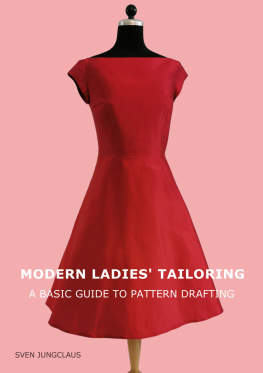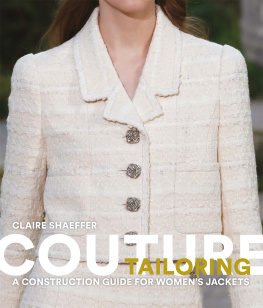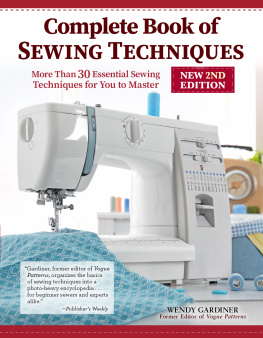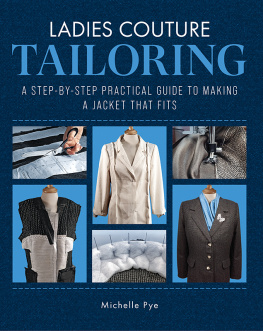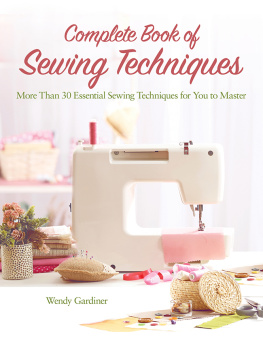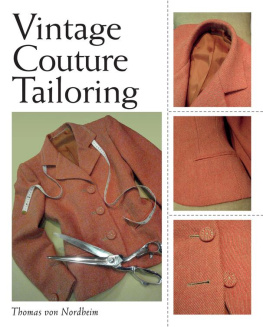THE CLASSIC GUIDE TO SEWING THE PERFECT JACKET
Tailoring



Copyright 2011 Creative Publishing international, Inc.
All rights reserved. No part of this work covered by the copyrights hereon may be
reproduced or used in any form or by any meansgraphic, electronic, or mechanical,
including photocopying, recording, taping of information on storage and retrieval
systemswithout the written permission of the publisher.
Due to differing conditions, materials, and skill levels, the publisher and various
manufacturers disclaim any liability for unsatisfactory results or injury due to
improper use of tools, materials, or information in this publication.
First published in the United States of America by
Creative Publishing international, Inc., a member of
Quayside Publishing Group
400 First Avenue North
Suite 300
Minneapolis, MN 55401
1-800-328-3895
www.creativepub.com or www.qbookshop.com
Visit www.Craftside.Typepad.com for a behind-the-scenes peek at our crafty world!
ISBN-13: 978-1-58923-609-7
ISBN-10: 1-58923-609-2
10 9 8 7 6 5 4 3 2 1
Digital edition: 978-1-61060-191-7
Softcover edition: 978-1-58923-6-097
Library of Congress Cataloging in Publication data previously cataloged as:
Tailoring : the classic guide to sewing the perfect jacket / by the
editors of Creative Publishing International.
p. cm.
ISBN 1-58923-230-5 (soft cover)
1. Jackets. 2. Tailoring (Womens) I. Creative Publishing
International.
TT535.T37 2005
646.43304-dc22
2005006397
Proofreader: Karen Ruth
Book Design & Layout: Lois Stanfield
Cover Design: Mighty Media, Inc.
Printed in China
Acknowledgments
Photos on , 18, 74, and 120
courtesy of The McCall Pattern
Company. All patterns are subject to
availability and are copyrighted by
the McCall Pattern Company.

CONTENTS

HOW TO USE THIS BOOK
One of the most satisfying sewing projects is a tailored jacket or coat. Tailoring takes you through the process step-by-step. It guides you in selecting the tailoring method most appropriate for your fabric and pattern choice, as well as for your skill level and available sewing time.
Most tailoring procedures are not difficult. Many are used in everyday dressmaking, so progressing to a tailored garment is a natural step. Although tailored usually implies a garment with notched collar and lapels and a lining, many of the techniques used to create such a garment are also used in constructing other jacket and coat styles, including unlined ones.
Custom tailoring was once the only technique for creating a professionally tailored garment, but now the machine and fusible methods are natural choices when faster, easier construction is desired. All three methods are included in Tailoring with suggestions for where and how to use them alone or in combination.
Making Selections
The first section of this book describes the three tailoring methods and explains how to choose garment fabrics, interfacings, lining fabrics, and notions for tailoring. Because some fabrics respond better to tailoring than others, information is included to help you evaluate fabrics and choose only those that are appropriate.
Interfacings and the methods used to apply them make the difference in the appearance of a professionally tailored garment, so you will want to test new techniques and interfacings before using them in a garment. If you choose tailoring with fusible interfacings, be sure to review the fusing directions and the guidelines for selecting and evaluating fusible interfacings.
Tips and Tools
Even if you feel confident about your sewing skills, take the time to review the section on tips and tools before starting your tailoring project. Some of the hand stitches used in tailoring may be new to you. Read about these stitches, and practice those that are unfamiliar before using them in your jacket or coat.
Accurate cutting and marking, precise machine stitching, and careful trimming and pressing are also required to create a beautifully tailored jacket or coat. We have included a listing of the tools helpful for tailoring a garment. You may already have most of these tools, so investment in new tools may be minimal.
Before You Sew
Because a tailored jacket or coat is shaped to the body, you may need to adjust the pattern to fit your figure. Tailoring includes fitting guidelines and directions for pin-fitting the pattern and making a test garment to perfect the fit, along with common fitting adjustments for tailored garments.
Professional tailors use specially shaped interfacing pieces to create support and shaping in a tailored garment. Use the directions in this section to cut the interfacing the way tailors do. To ensure that your garment fabric and interfacings are compatible and that the finished garment will endure repeated cleanings without shrinkage, follow the directions for preparing the fabric before cutting and marking.
Tailoring and Finishing Techniques
Most pattern guidesheets are written according to space limitations, and the instructions are generalized to cover a wide range of fabrics and skill levels. For truly professional results, use the pattern instructions as a general guide and supplement them with the more detailed instructions that are included in this book.
The tailoring techniques are organized according to the sequence recommended for constructing a tailored jacket and may vary from the order usually given in the pattern guidesheet. The undercollar is tailored first to give you an idea of how the fabric handles and an opportunity to practice unfamiliar techniques on a smaller piece of fabric before proceeding to the lapels.
Custom tailoring methods are shown first, followed by the faster machine and fusible methods. Even if you select one of the faster methods, read through the custom method first for a better understanding of the shaping technique and desired results. Regardless of the tailoring method you choose, the result will be a beautifully tailored jacket or coat.
MAKING SELECTIONS


There are many choices to make as you begin any jacket or coat project. Selecting a pattern is a good place to start. Browsing through the pattern books, you will find many style options in the way the garment is meant to fit and the level of detail work involved. With pattern in hand, your next selection, and probably the most enjoyable one, will be the fabric. Choose high-quality fabric for both the outer garment and lining that will be long-lasting and easy to work with. The guidelines in this section will help you make this important decision. Carefully consider your options for selecting interfacing and notions, too, as these choices depend on the method of tailoring you want to follow.
Next page


